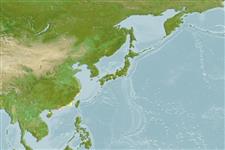>
Tetraodontiformes (Puffers and filefishes) >
Tetraodontidae (Puffers) > Tetraodontinae
Etymology: Takifugu: A Japanese word with several meanings; taki = waterfall + fugu = fish; it could be also understood as taki = to be cooked in liquid + fugu = a venomous fish.
More on author: Linnaeus.
Environment: milieu / climate zone / depth range / distribution range
นิเวศวิทยา
เกี่ยวกับทะเล,น้ำเค็ม; น้ำจืด; กร่อย สัตว์น้ำหน้าดิน; ปลาที่อพยพจากแหล่งน้ำเค็มไปวางไข่ในแหล่งน้ำจืด (Ref. 51243). Subtropical
Asia: China and Viet Nam.
ขนาด / น้ำหนัก / Age
Maturity: Lm ? range ? - ? cm
Max length : 17.6 cm TL เพศผู้/กระเทย; (Ref. 108876); common length : 10.2 cm SL เพศผู้/กระเทย; (Ref. 35840); น้ำหนักสูงสุดที่มีการรายงาน: 103.70 g (Ref. 108876)
Juveniles are found in brackish and fresh waters, but adults need marine conditions. Deadly poisonous to eat.
Life cycle and mating behavior
Maturities | การสืบพันธุ์ | Spawnings | Egg(s) | Fecundities | ตัวอ่อน
Kuang, Y., 1991. Tetraodontiformes. p. 536-540. In J.-H. Pan, L. Zhong, C.-Y. Zheng, H.-L. Wu and J.-H. Liu (eds). 1991. The freshwater fishes of Guangdong Province. Guangdong Science and Technology Press, Guangzhou. 589 p. (Ref. 33425)
IUCN Red List Status (Ref. 130435)
Threat to humans
Poisonous to eat
Human uses
เครื่องมือ
Special reports
Download XML
แหล่งที่มาจากอินเตอร์เน็ต
Estimates based on models
Preferred temperature (Ref.
123201): 18.8 - 26.5, mean 24.7 °C (based on 112 cells).
Phylogenetic diversity index (Ref.
82804): PD
50 = 0.5000 [Uniqueness, from 0.5 = low to 2.0 = high].
Bayesian length-weight: a=0.02089 (0.01260 - 0.03464), b=3.02 (2.89 - 3.15), in cm total length, based on LWR estimates for this species & Genus-body shape (Ref.
93245).
ระดับชั้นอาหาร (Ref.
69278): 3.3 ±0.3 se; based on size and trophs of closest relatives
ความสามารถในการกลับคืนสู่ปกติ (Ref.
120179): ความสูง, เวลาต่ำสุดที่จะทำให้ประชากรเพิ่มขึ้นเป็น 2 เท่าใช้เวลาน้อยกว่า 15 เดือน (Preliminary K or Fecundity.).
Fishing Vulnerability (Ref.
59153): Low vulnerability (10 of 100).
